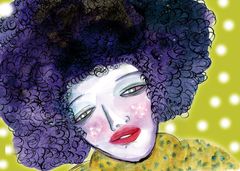There is something peculiar about the world we live in when lipstick becomes not merely a fashion statement, but a symbol of life and liberation. As Europe approaches the tantalising light at the end of the pandemic tunnel, women break free from year-long confines and emerge from their homes—with makeup, coiffed hair and glowing skin. Masks out, lipstick in. Smiles can finally be seen. “Putting on lipstick again will be a symbol of returning to life,” declared Jean-Paul Agon, chairman of the world’s largest cosmetics company, L’Oréal. The $500 billion global beauty industry is predicting that the end of the pandemic will be greeted with the same exuberance as in the roaring 1920s. When World War 1, and the catastrophic Spanish flu pandemic ended, people swung to the other extreme—partying, preening, overspending, kicking their heels high. The same freedom from fear and the release of bottled emotions now propel people to feast on a fiesta of fashion, fragrances and face enhancers.
Said Margarita Arriagada, CEO of Valde Beauty, “There is a pent-up desire to glam up.” Leading beauty businesses are already enjoying double digit growth. Pandemic lockdowns savaged fashion and cosmetics industries with closed shops and salons. Before Covid-19, 85 per cent of beauty products were sold in shops. Even luxury customers preferred to shop in the showrooms. Presumably, the ecstasy of shopping is enhanced by the envy of onlookers as they stride out swinging Louis Vuitton or Prada shopping bags. Still, shopping did not become extinct during lockdowns. It shifted online. E-commerce and the pivot to Asia, especially by affluent Chinese customers, offset some losses. Entrepreneurs, like the Portuguese businessman José Neves, profited from this trend. His online luxury marketplace for men and women that showcases high-end fashion brands from around the world became popular. During Covid-19, Neves’s wealth crossed $2.2 billion.
As the rich got richer during the pandemic, they spent even more money, time, and energy on pampering themselves. An ambassador for the idle rich, Melania Trump became unchained not only from the pandemic but also from the shackles of the White House. In her sprawling Mar-a-Lago resort in sunny Florida’s Palm Beach, she visits her in-house spa twice a day. This enables her to peacefully practise a miracle mantra for eternal youth: Rinse, Relax, Rejuvenate. Repeat.
The pandemic exacerbated existing income inequalities. Joblessness and poverty skyrocketed. Over 36 million Americans went hungry and waited in queues to get free food while the sales of Godiva’s “luxury” chocolates rose. Heineken Lager Beer announced new products to spoil its fast-expanding market—women—with tantalising choices: Zero alcohol beer for lunches, sparkling alcohol water, low alcohol beer for weekday evenings and strong ones for Friday nights. Beauty is no longer skin-deep; it encompasses diversity, nature and well-being. Many companies report that their premium products—especially in the eye makeup, wellness and self-care categories—sold briskly during the pandemic.
Lipstick sales are usually recession proof. Cosmetics billionaire Leonard Lauder invented the so-called “lipstick index” that gauges how women, during bad times, splurge on a small “affordable luxury” like lipstick, while forgoing expensive clothes and shoes. As fashion icon Coco Chanel famously said, “If you are sad, put on more lipstick and attack.” This time though, lipstick sales plummeted because of mask-wearing. But now, lipstick is the comeback kid in the makeup kit. Native tribesmen used war paint to convey strength, ferocity and success before battle. Women now apply face paint and lipstick, ready to battle for fun.
Pratap is an author and journalist.


